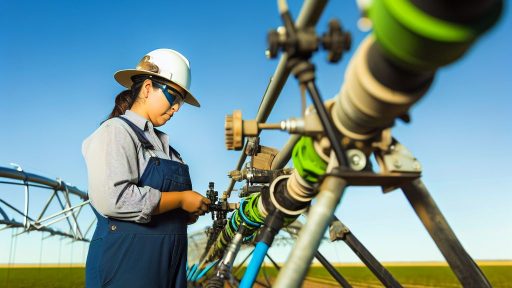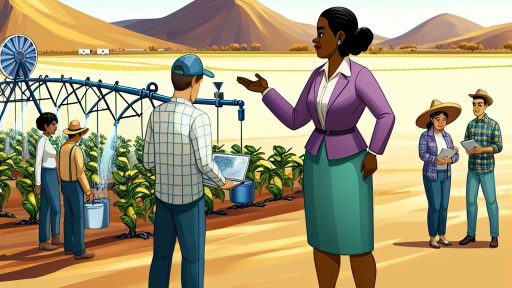Introduction to Changing Rainfall Patterns
Global weather patterns are undergoing significant changes.
Rainfall patterns are becoming increasingly unpredictable.
This unpredictability affects agricultural practices worldwide.
Farmers depend on consistent rainfall for their crops.
As a result, shifts in rainfall can drastically impact yields.
Understanding the Impact on Agriculture
Changing rainfall levels can lead to droughts or floods.
Both extremes can harm crop production severely.
This, in turn, affects the food supply chain.
A decrease in crop yields raises concerns about food security.
Economic Implications of Rainfall Changes
Land prices are closely connected to agricultural productivity.
When yields decline, farmland value often follows suit.
Investors closely monitor rainfall forecasts for decision-making.
In regions facing drought, land prices typically decrease.
This trend raises questions about agricultural investment stability.
Adaptive Strategies in Agriculture
Farmers are adapting to changing conditions for resilience.
Transform Your Agribusiness
Unlock your farm's potential with expert advice tailored to your needs. Get actionable steps that drive real results.
Get StartedThey are investing in irrigation systems to combat drought.
Additionally, crop diversification helps mitigate risks.
Innovations in farming techniques also play a vital role.
Policy Considerations and Support
Government policies can substantially influence agricultural adaptation.
Subsidies for drought-resistant crops encourage innovation.
Furthermore, funding for water conservation projects is essential.
Effective policies can stabilize land prices amidst changes.
The Science Behind Rainfall Variability and Its Climatic Drivers
Understanding Rainfall Patterns
Rainfall patterns vary significantly across regions and seasons.
Climate change is a predominant factor influencing these patterns.
As temperatures rise, the atmosphere can hold more moisture.
This leads to increased variability in rainfall events.
Some areas may experience more intense storms, while others face droughts.
Key Climatic Drivers of Rainfall Variability
Several climatic drivers affect rainfall patterns globally.
- El Niño events often lead to unusual rainfall distributions.
- Changes in ocean temperatures significantly influence atmospheric conditions.
- Deforestation alters local climates, affecting precipitation levels.
These factors interact in complex ways to shape regional climates.
Consequently, understanding these interactions is vital for predicting future trends.
The Role of Agriculture
Agriculture relies heavily on stable and predictable rainfall patterns.
Farmers adjust their planting schedules based on expected precipitation.
Variability can threaten crop yields and food security.
Farmers in arid regions often face the harshest impacts of changing patterns.
Addressing the Challenges
Farmers can adopt techniques to mitigate the impacts of changing rainfall.
- Implementing rainwater harvesting systems enhances water availability.
- Utilizing drought-resistant crop varieties can increase resilience.
- Practicing sustainable land management helps maintain soil health.
These strategies are essential for adapting to shifting climatic conditions.
Ultimately, continued research will be necessary to refine these approaches.
Impact of Changing Rainfall on Crop Yields and Farming Practices
Effects on Crop Yields
Changing rainfall patterns directly affect crop yields.
Too much rain can lead to flooding, damaging crops.
Showcase Your Farming Business
Publish your professional farming services profile on our blog for a one-time fee of $200 and reach a dedicated audience of farmers and agribusiness owners.
Publish Your ProfileAdditionally, insufficient rainfall can cause droughts, reducing crop viability.
Farmers must adapt to these unpredictable conditions.
Increased variability in rainfall often leads to lower yields.
Consequently, farmers face greater financial risks.
Higher input costs and crop failures disproportionately affect small-scale farmers.
Prolonged dry spells disrupt planting and harvesting schedules.
In turn, this affects farmers’ income and food security.
Changes in Farming Practices
Farmers implement various strategies to combat changing rainfall patterns.
They may adopt drought-resistant crop varieties to enhance resilience.
Additionally, improved irrigation systems help manage water supply efficiently.
Crop rotation practices are also increasingly employed to maintain soil health.
Furthermore, farmers may utilize cover crops to reduce soil erosion.
These adjustments require knowledge and resources that not all farmers possess.
As a result, larger farms often outperform smaller ones in adapting.
Technological Innovations
Technology plays a vital role in managing changing rainfall patterns.
Farmers can now use weather forecasting tools to make informed decisions.
Remote sensing technologies help monitor soil moisture levels precisely.
Such innovations enable proactive responses to water needs.
Additionally, precision agriculture minimizes waste of water and resources.
Investment in technology is crucial for sustainable farming practices.
Government Policies and Support
Governments can assist farmers in adapting to new rainfall patterns.
Subsidies for drought-resistant crops and irrigation systems can be beneficial.
Research funding for agricultural innovations enhances resilience.
Training programs inform farmers about sustainable practices.
Collaboration among stakeholders is essential for effective implementation.
Ultimately, governments must prioritize agricultural stability and sustainability.
Explore Further: How Climate Change Affects Crop Yields and Land Values
Historical Trends in Agricultural Land Prices Relative to Rainfall Changes
Overview of Agricultural Land Prices
Agricultural land prices have fluctuated throughout history.
These fluctuations often correlate with changes in rainfall patterns.
Regions with stable rainfall typically saw higher land values.
Conversely, areas experiencing drought faced declining prices.
Understanding these trends offers insights into land investment decisions.
Impact of Rainfall Changes on Land Values
Rainfall directly influences crop yields and agricultural productivity.
Inconsistent rainfall creates uncertainty for farmers and investors.
For example, severe drought conditions reduce crop output significantly.
As a result, land prices in drought-affected areas tend to drop.
In contrast, regions with abundant rainfall can see land prices rise.
Historical Case Studies
One case study is the Midwest during the 1930s Dust Bowl.
During this period, land prices plummeted due to severe drought.
Farmers faced significant losses, leading to foreclosures.
Showcase Your Farming Business
Publish your professional farming services profile on our blog for a one-time fee of $200 and reach a dedicated audience of farmers and agribusiness owners.
Publish Your ProfileSimilarly, in the 1990s, California’s central valley saw increased prices.
Abundant rainfall and improved irrigation boosted agricultural productivity.
Long-term Trends and Predictions
Long-term trends have shown variability based on climate change projections.
Increasing temperatures may lead to more erratic rainfall patterns.
As a result, regions may experience heightened risks of drought.
This instability could adversely affect land values over time.
Investors must consider these trends while making decisions.
Learn More: How Tornadoes Affect Farmland Prices in the United States
Regional Variations in Rainfall Impact on Land Valuation
Understanding the Relationship
Rainfall patterns directly influence agricultural productivity.
As a result, land values fluctuate according to water availability.
In regions with unpredictable rainfall, land prices tend to decrease.
Conversely, consistent rainfall usually boosts land values significantly.
Case Studies and Examples
For instance, areas in the Midwest U.S. enjoy stable rain patterns.
This stability often leads to higher land prices compared to drought-prone regions.
Similarly, Central California has experienced increased land values due to reliable rainfall.
Farmers invest more in regions with favorable climates and rainfall.
Impact of Climate Change
Climate change is altering traditional rainfall patterns globally.
Unpredicted changes can disrupt existing agricultural plans.
As a result, land valuations may become more volatile.
Regions that previously thrived may find their land losing value.
Market Perceptions and Investor Behavior
Land prices are also shaped by market perceptions of risk.
Investors often flock to areas perceived as safe bets.
As rainfall becomes less predictable, investor confidence can waver.
This leads to decreased investment in certain agricultural landscapes.
The Role of Government Policies
Government policies play a vital role in agricultural land valuation.
Subsidies and support for drought-resistant crops can enhance land value.
Conversely, lack of support in regions facing water scarcity can hurt prices.
Effective policies can mitigate the negative impacts of changing rainfall patterns.
Delve into the Subject: Creating Climate-Resilient Properties With Agroforestry Approaches
The Role of Government Policies and Subsidies in Mitigating Rainfall Effects
Understanding the Importance of Policy Frameworks
Government policies play a crucial role in agriculture.
These policies help balance the impact of changing rainfall patterns.
Furthermore, they provide essential support to farmers.
Effective policies can stabilize agricultural land prices.
Types of Subsidies Available
Various subsidies are available to farmers facing rainfall challenges.
Direct financial aid assists with income losses during droughts.
Moreover, crop insurance programs offer protection against poor yields.
Additionally, grants for conservation initiatives encourage sustainable practices.
Encouraging Adaptive Farming Practices
Government initiatives promote adaptive farming practices.
These practices include drought-resistant crop varieties.
Also, they encourage soil conservation techniques to retain moisture.
Showcase Your Farming Business
Publish your professional farming services profile on our blog for a one-time fee of $200 and reach a dedicated audience of farmers and agribusiness owners.
Publish Your ProfileSuch measures improve resilience to varying rainfall patterns.
Collaboration with Agricultural Organizations
Collaboration enhances the effectiveness of government policies.
Local agricultural organizations often provide valuable insights.
They can help tailor policies to specific regional needs.
This approach ensures that subsidies reach those who need them most.
Assessing Long-Term Outcomes
Long-term assessments of government policies guide adjustments.
Regular evaluations can identify successes and areas for improvement.
Additionally, feedback from farmers helps refine subsidy programs.
Ultimately, effective policies can lead to stable agricultural land prices.
Uncover the Details: How Water Rights Policies Influence Agricultural Land Prices

Case Studies: Analyzing Specific Regions Experiencing Dramatic Rainfall Changes
Impact on Agricultural Land Prices in California
California’s agriculture heavily relies on consistent rainfall patterns.
Recent years have shown unpredictable weather, complicating farming efforts.
Specifically, areas experiencing drought witness a drop in land prices.
This occurs due to decreasing yield expectations from crops.
Conversely, regions gaining more rainfall see rising land prices.
Investors view these areas as more viable for farming investments.
As a result, the demand for land increases, driving prices up.
The Midwest’s Shifting Rainfall Patterns
The Midwest faces significant changes affecting agricultural practices.
Farmers are adapting to increased rainfall and flooding risks.
This evolution has mixed effects on land pricing across the region.
Areas prone to flooding now experience a decrease in value.
However, land with improved drainage has seen increased demand.
Oversupply of crops due to excessive rain can also influence prices.
Farmers are cautious about investing in these newly risky regions.
Case Study: The Southeastern United States
The Southeastern U.S. grapples with both droughts and heavy rainfall.
These fluctuations significantly impact agricultural productivity.
As a result, investors reconsider land values and agricultural viability.
Drought-affected areas see land prices fall dramatically.
In contrast, regions benefiting from consistent rainfall observe price increases.
Farmers are investing in strategies to better manage water usage.
This proactive approach aims to stabilize land prices over time.
International Perspectives: Agricultural Markets in Australia
Australia faces unique challenges with its agricultural land prices.
Fluctuating rainfall patterns make farming operations unpredictable.
Some areas undergo extreme drought, sharply lowering land prices.
Conversely, regions with a reliable water supply attract higher investments.
Government incentives encourage investment in water management projects.
This strategy aims to minimize future fluctuations in land prices.
Overall, investors must consider these dynamics when purchasing land.
Future Projections
Impact of Climate Change on Rainfall Patterns
Climate change significantly alters global rainfall patterns.
This change affects both frequency and intensity of rainfall.
Showcase Your Farming Business
Publish your professional farming services profile on our blog for a one-time fee of $200 and reach a dedicated audience of farmers and agribusiness owners.
Publish Your ProfileRegions may experience prolonged droughts or excessive rainfall.
Such shifts will directly impact agricultural productivity.
Farmers must adapt to unpredictable weather conditions.
Consequently, this unpredictability complicates planting and harvesting schedules.
Effects on Agricultural Land Prices
Changing rainfall patterns influence agricultural land values.
With unpredictable rainfall, farmers face increased risks.
Higher risk typically leads to lower land prices.
In contrast, regions with stable rainfall patterns see higher demand.
Investors seek properties that promise greater stability.
Therefore, areas with favorable climate conditions maintain higher prices.
Regional Variations in Impact
Different regions will experience unique impacts due to climate change.
For instance, arid areas may face severe water shortages.
These shortages can reduce crop yields and land attractiveness.
Conversely, regions receiving more rainfall might benefit.
Increased water availability can enhance agricultural outputs.
Thus, land prices in those areas may rise significantly.
Adapting to Changing Conditions
Farmers and investors must develop strategies to adapt.
Implementing sustainable farming practices proves essential.
This can include crop diversification and improved irrigation.
Additionally, the use of technology aids in monitoring rainfall patterns.
Thus, informed decisions regarding land investments can be made.
Ultimately, proactive measures can help stabilize land prices.
Strategies for Farmers and Investors
Understanding the Impact of Rainfall Changes
Farmers must recognize how shifting rainfall patterns affect crop yields.
Moreover, rainfall variability influences soil moisture and fertility.
Consequently, these factors directly affect agricultural land prices.
Adopting Innovative Farming Techniques
Farmers can employ advanced irrigation systems to conserve water.
They should also consider drought-resistant crop varieties.
Additionally, implementing soil conservation practices is essential.
Embracing Data and Technology
Utilizing weather forecasting tools helps farmers make informed decisions.
Furthermore, precision farming techniques can optimize resource use.
Investors should also consider technology-driven agricultural startups.
Researching Local Market Trends
Understanding local agricultural market trends aids strategic decisions.
Farmers might benefit from collaborating with agricultural experts.
Investors should analyze geographical regions with favorable climates.
Preparing for Uncertain Futures
Diversifying crop portfolios reduces dependence on a single crop.
Farmers should also explore alternative income streams, such as agritourism.
Moreover, staying informed about climate change is crucial for adaptation.
Additional Resources
Impacts of climate change on the fate of contaminants through …




